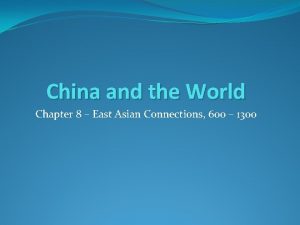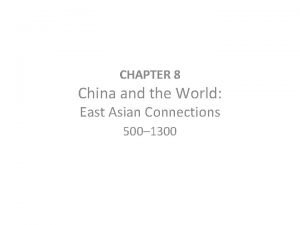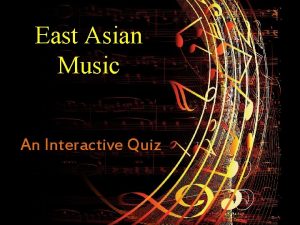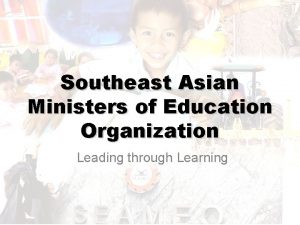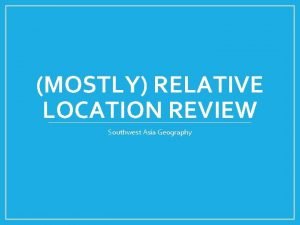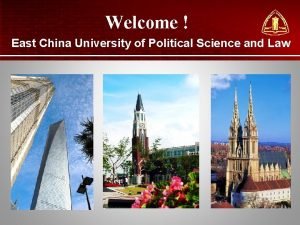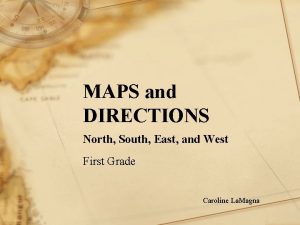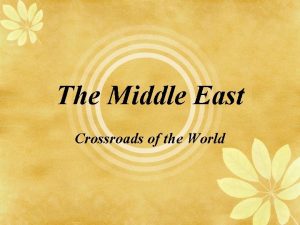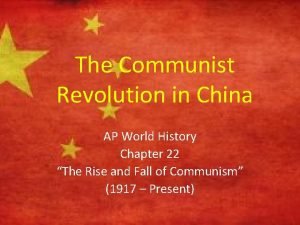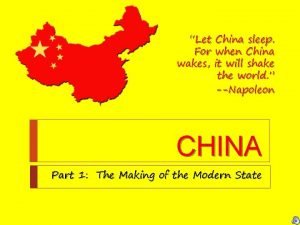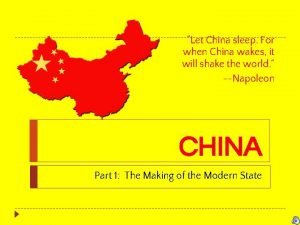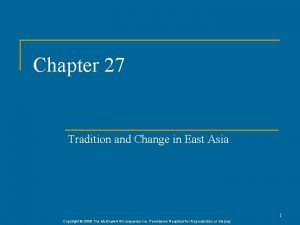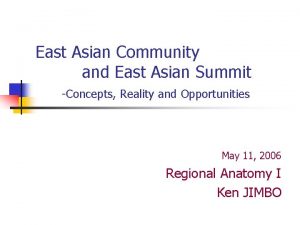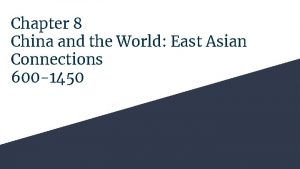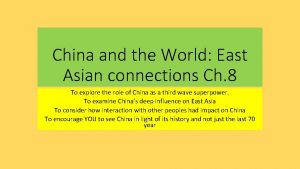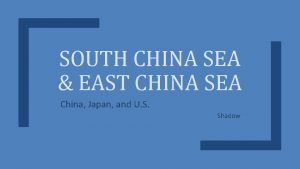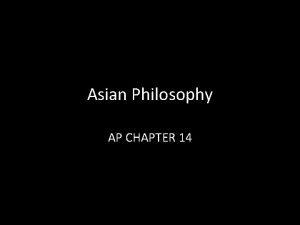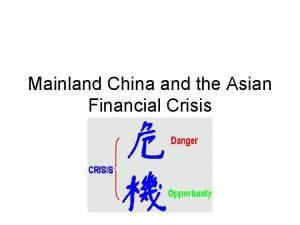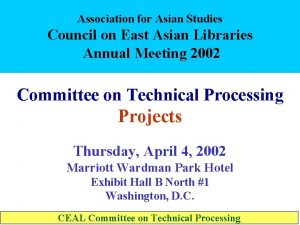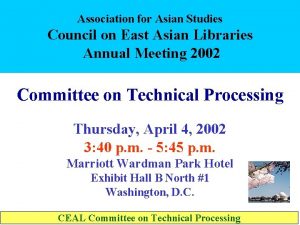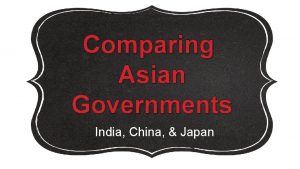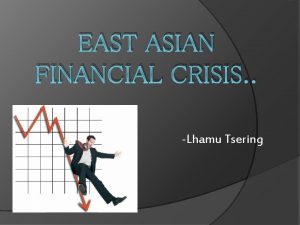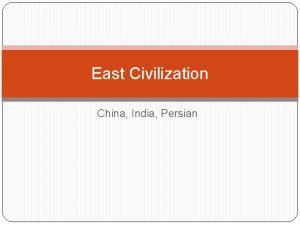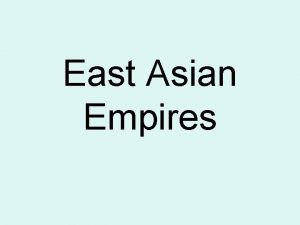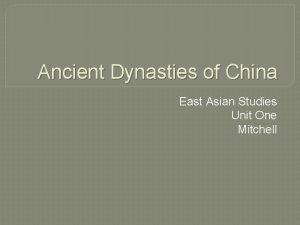CHAPTER 8 China and the World East Asian




















- Slides: 20

CHAPTER 8 China and the World: East Asian Connections 500– 1300


I. Together Again: The Reemergence of a Unified China A. A “Golden Age” of Chinese Achievement 1. Sui (589– 618), Tang (618– 907), & Song (960– 1279) a. While both Han and Rome collapsed, China was reunified under the Sui. The Sui marked many achievements such as dramatic expansion of the canals but proved to be a short-lived dynasty as their emperors were harsh and warlike. The Tang and Song built upon the achievements of the Sui and established a state system that would last over a thousand years. The Tang and Song were noteworthy for their political achievements but also for their cultural vibrancy and economic dynamism.

I. Together Again: The Reemergence of a Unified China 2. Bureaucracy and exam system a. These dynasties formalized and expanded the Confucian-based exam system. In theory, they cracked down on cheating, and the exams were open to all regardless of class. However, there were irregularities, and the wealthy elite had an economic advantage in that they could pay for schooling and tutors. Nonetheless, schools and colleges grew in number, and the system that trained the efficient bureaucracy that governed China was an apparent success.

I. Together Again: The Reemergence of a Unified China 3. Economic boom, population growth, and urbanization: a. Thanks to investments in infrastructure such as the canal system, which allowed the cheap transportation of rice and wheat over long distances, there was a major economic boom in this period. In addition to staples, Chinese farmers could produce specialized crops for specific markets. More food meant more people, and China more than doubled its population in this period. Cities saw tremendous growth and the development of increasingly productive and sophisticated industries. The boom did have clear environmental consequences with much of China’s old growth forest being cut down for fuel.

I. Together Again: The Reemergence of a Unified China 4. Hangzhou: a. With a population of over one million, this was the world’s largest city. Hangzhou enjoyed a vibrant cultural life with a lively entertainment industry and growing print culture.




I. Together Again: The Reemergence of a Unified China B. Women in the Song Dynasty 1. Tang freedoms, Song patriarchy a. While elite women enjoyed various freedoms in the Tang dynasty (due to its cultural influences from the nomadic steppes), the Song era saw a renewed patriarchy based on a very conservative reading of Confucius. 2. Weak and distracting a. In the Song, men were to be scholars and administrators and women were viewed as weak and distracting.

I. Together Again: The Reemergence of a Unified China 3. Foot binding: a. The practice grew in popularity under the Song. While associated with a construction of frail beauty, the practice also restricted the freedom of women. 4. Changing job opportunities: a. With the commercialization of weaving, many were pushed out of the textile labor force. However, they found new jobs in other professions such as domestic service, retail, and entertainment (including work as concubines). Women did see an increase in their property rights, as well as new access to education.



II. China and the Northern Nomads: A Chinese World Order in the Making A. The Tribute System in Theory 1. China as the “middle kingdom” a. China viewed itself as the “middle kingdom, ” the height of civilization radiating civilization and culture outwards. Inferior barbarians were expected to recognize Chinese superiority.

II. China and the Northern Nomads: A Chinese World Order in the Making 2. Tribute missions and kowtows for gifts and prestige: a. Foreigners were expected to send tribute missions of ceremonial gifts to the capital and perform the kowtow (a series of bows to the ground) to show their recognition of China’s superiority. In return, the missions would get various gifts of great value and the prestige of being allied with China. 3. A way to manage barbarians: a. For China, this was a way to manage inferior barbarians on the periphery.

II. China and the Northern Nomads: A Chinese World Order in the Making B. The Tribute System in Practice 1. Nomadic raids into China a. In reality, China was vulnerable to raids from the warlike horsemen of the steppes. At times, they not only raided but also conquered parts of China. 2. “Gifts” to Xiongnu and Turkic nomads a. The reality of the tribute system for these stronger groups was essentially that the Chinese paid protection to the raiders. Large gifts of wine, silk, and grain kept the nomads from having to steal from the Chinese and allowed the Chinese court to maintain the fiction of its invulnerability. Nonetheless, in times of weakness, China remained vulnerable and the Khitan (907– 1125) and Jin or Jurchen (1115– 1234) seized parts of northern China after the fall of the Tang and would force the Song to give them silver, silk, and tea.


II. China and the Northern Nomads: A Chinese World Order in the Making C. Cultural Influence across an Ecological Frontier 1. Chinese agriculture and lifestyle not possible in the steppes a. While some aspects of Chinese culture made their way north, Chinese style agriculture and material life was impossible in the steppes and grasslands of Central Asia. Thus, there was little way to replicate being Chinese amongst the Turkic nomads.

II. China and the Northern Nomads: A Chinese World Order in the Making 2. Southern people absorbed into Chinese culture: a. In contrast, the indigenous people of southern China were almost completely absorbed into the great Chinese cultural world. 3. Turkic influence on Tang and Song courts and military: a. As both the Tang and Song dynasties had their origins in mixed Sino-Turkic families, there was a great influence in the court culture. Turkic battle techniques were also used by Chinese generals in the field.

II. China and the Northern Nomads: A Chinese World Order in the Making 4. Culture of “western barbarians” fashionable in Tang: a. For some time in the Tang dynasty, there was a fad for things from the west (Central Asia, Persia, India, and Arabia). Music, fashion, dancing, and other aspects of culture were popular amongst the northern Chinese elites. 5. Nativist backlash in the south: a. The southern Chinese, who saw themselves as the heirs to the Han, were extremely critical of the fad for things foreign.
 Chapter 8 china and the world
Chapter 8 china and the world Chapter 8 china and the world east asian connections
Chapter 8 china and the world east asian connections Sakura song meter
Sakura song meter South east asian ministers of education organization
South east asian ministers of education organization Relative location of israel
Relative location of israel East is east and west is west
East is east and west is west Yellow sea and east china sea
Yellow sea and east china sea Ecupl
Ecupl Pacific islander inventions
Pacific islander inventions Winds that blow over short distances are called
Winds that blow over short distances are called Laissez faire theory
Laissez faire theory Ap world history chapter 25 africa and the atlantic world
Ap world history chapter 25 africa and the atlantic world West north east
West north east Crossroads of the world middle east
Crossroads of the world middle east The great leap forward ap world history
The great leap forward ap world history Why didn't china discover the new world
Why didn't china discover the new world Let china sleep quote meaning
Let china sleep quote meaning Let china sleep
Let china sleep Difference between african elephant and asian elephant
Difference between african elephant and asian elephant Black and asian counselling network
Black and asian counselling network Chapter 27 tradition and change in east asia
Chapter 27 tradition and change in east asia
